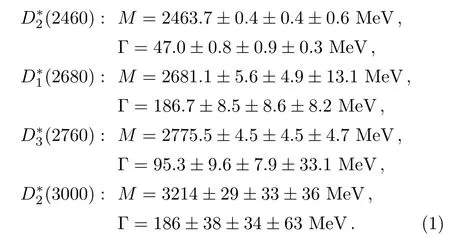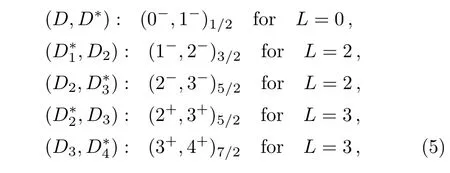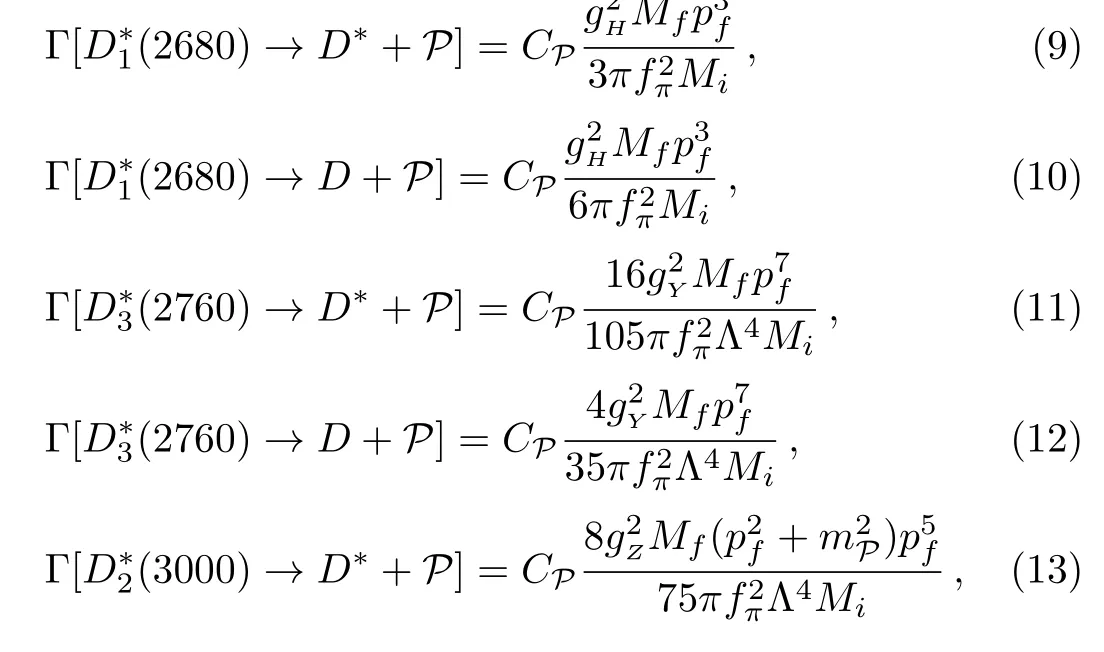Strong Decays of Charm Mesons (2680),(2760),(3000)?
Zhi-Gang Wang(王志剛)
Department of Physics,North China Electric Power University,Baoding 071003,China
1 Introduction
Recently,the LHCb collaboration used the Dalitz plot analysis technique to study the resonant substructures of B?→ D+π?π?decays in a data sample corresponding to 3.0 fb?1of pp collision data recorded by the LHCb experiment during 2011 and 2012.[1]A modelindependent analysis of the angular moments indicated the presence of resonances with spins 1,2,and 3 at the D+π?mass spectrum.[1]The measured Breit–Wigner masses and widths of those charm mesons are




The energy gap MD?2(3000)0?MD?J(3000)0=206 MeV,the(3000)0and(3000)0are different particles,see Table 1.The strong decays(3000)0→D+π?and(3000)+→D0π+were observed,[4]we can draw the conclusion that the(3000)have the possible spin-parity JP=0+,1?,2+,3?,4+,...The recent updated values of the masses of the 2P 0+and 2+states are 2.931 GeV and 2.957 GeV respectively from the relativized quark model,[9]we can tentatively assign the(3000)observed by the LHCb collaboration to be the 2P 0+or 2+state,for detailed discussions about other possible assignments,one can consult Ref.[8].

Table 1 The experimental values of the masses of the charm mesons,we present them in the form meson/mass,the unit of the mass is MeV.In the last column,we present the possible assignments of JP.
If the 1D 2?stateand 1D 3?statehave approximately degenerate masses,then the energy gap

In the article,we tentatively assign the higher charm mesons(2680),(2760)and(3000)to be the 2S 1?,1D 3?and 1F 2+states,respectively,and study their two-body strong decays with the heavy meson effective theory.Additional support can be obtained by the measuring the ratios among those strong decays.Charm meson spectroscopy provides good opportunities to study QCD predictions based on the quark models. In the past years,there have been gained some new experimental knowledge of the masses,widths and spins of the higher charm mesons and charm-strange mesons.[2]The spectroscopic identification for the new higher states call for more experimental data and more theoretical works.In the present work,we will focus on the(2680),(2760),and(3000).
The article is arranged as follows:We study the strong decays of the(2680),with the heavy meson effective theory in Sec.2,in Sec.3,we present the numerical results and discussions,and Sec.4 is reserved for our conclusions.
2 Strong Decays with Heavy Meson E ff ective Theory

where the radial quantum numbers 1,2,3,...are not shown explicitly.In the heavy meson effective theory,the spin doublets(D,D?),(D2,),and(,D3)can be described by the super- fields Ha,Yaand Za,respectively,[19]

where the four vector vμsatisfies v2=1,the a is the flavor index of the light antiquark,the charm meson fields D(?)contain a factorand have dimension of mass 3/2.
The light pseudoscalar mesons are described by the fieldswhere the matrix

and the decay constant fπ=130 MeV. In this article,we choose the definition?0|ˉu(0)γαγ5d(0)|π(p)?=ifπpα.On the other hand,if we choose the definitionthen fπ=92 MeV.
We write down the heavy meson chiral Lagrangians LH,LYand LZdescribing the strong decays to the ground state charm mesons and light pseudoscalar mesons in the leading order approximation:[5,8,20]

where

the gH,andare hadronic coupling constants,the Λ is chiral symmetry-breaking energy scale and chosen as Λ=1 GeV.
From the heavy meson chiral Lagrangians,we can obtain the partial decay widths Γ for the two-body strong decays to the final states D?P and DP,where the P denotes the light pseudoscalar mesons,[8,21]


where

the i and f denote the initial and final state charm mesons,respectively,D?=D?0,D?+,,D=D0,The coefficients Cπ±=CK±=CK0=CˉK0=1,Cπ0=1/2 and Cη=1/6 or 2/3.The values Cη=1/6 and 2/3 correspond to the initial states cˉu(or cˉd)and cˉs,respectively.
3 Numerical Results
We take the masses of the light pseudoscalar mesons and the ground state charm mesons from the Particle Data Group,Mπ+=139.57 MeV,Mπ0=134.9766 MeV,MK+=493.677 MeV,Mη=547.862 MeV,MD+=1869.5 MeV,MD0=1864.84 MeV,MD+s=1969.0 MeV,MD?+=2010.27 MeV,MD?0=2006.97 MeV,MD?+s=2112.1 MeV.[2]
Now we can obtain the partial decay widths from Eqs.(9)–(14),the numerical values are shown in Table 2,where we retain the hadronic coupling constants gH,gYand gZ.The LHCb collaboration measured the masses and widths of the(2680),(2760),(3000),but did not measure the branching fractions of the twobody strong decays(2680)→D+π?,(2760)→D+π?,(3000)→D+π?,we have no experimental data to fit the hadronic coupling constants gH,gY,and gZ.We can avoid the unknown hadronic coupling constants gH,gY,and gZby studying the ratiosandamong the strong decays of the(2680),(2760),and(3000)mesons,respectively,

In Table 3,we present the ratios RD?1(2680)→D(?)P,andBy measuring those ratios,we can test the possible assignments and shed light on the nature of the(2680),(2760),(3000)mesons.The ratio between the kinematically allowed(or main)decays of the(2460)is Γ[(2460)→D+π?]/Γ[(2460)→D?+π?]=2.29 from the heavy meson effective theory in the leading order approximation,[8]which differs from the ratiosand(3000)→D+π?.As far as experimental identifications of the charm mesons or charm-strange mesons are concerned,we can measure the mass spectra,angular momenta and parities of the D?P,DP systems to distinguish theetc.

Table 2 The strong decay widths of the three higher charm mesons with possible assignments.

Table 3The ratios RD?1(2680)→D(?)P,RD?3(2760)→D(?)P,and RD?2(3000)→D(?)Pamong the strong decays of the three higher charm mesons.
4 Conclusion
In this article,we tentatively assign the higher charm mesons(2680),,andto be the 2S 1?,1D 3?and 1F 2+states,respectively,and resort to the heavy meson effective Lagrangians in the leading order approximation to study their two-body strong decays to the ground state charm mesons and the light pseudoscalar mesons.We obtain the ratios RD?1(2680)→D(?)P,RD?3(2760)→D(?)P,and RD?2(3000)→D(?)Pamong the strong decays of the(2680),(2760),(3000)mesons,which can be confronted to the experimental data in the future at the LHCb,BESIII,KEK-B,and shed light on the nature of the(2680),(2760),(3000)mesons.
[1]R.Aaij,et al.,arXiv:1608.01289[hep-ex].
[2]K.A.Olive,et al.,Chin.Phys.C 38(2014)090001.
[3]P.del Amo Sanchez,et al.,Phys.Rev.D 82(2010)111101.
[4]R.Aaij,et al.,J.High Energy Phys.1309(2013)145.
[5]Z.G.Wang,Phys.Rev.D 83(2011)014009.
[6]P.Colangelo,F.De Fazio,and S.Nicotri,Phys.Lett.B 642(2006)48;P.Colangelo,F.De Fazio,F.Giannuzzi,and S.Nicotri,Phys.Rev.D 86(2012)054024.
[7]A.M.Badalian and B.L.G.Bakker,Phys.Rev.D 84(2011)034006;Q.F.Lu and D.M.Li,Phys.Rev.D 90(2014)054024;Q.T.Song,D.Y.Chen,X.Liu,and T.Matsuki,Phys.Rev.D 92(2015)074011;B.Chen,X.Liu,and A.Zhang,Phys.Rev.D 92(2015)034005.
[8]Z.G.Wang,Phys.Rev.D 88(2013)114003.
[9]S.Godfrey and K.Moats,Phys.Rev.D 93(2016)034035.
[10]R.Aaij,et al.,Phys.Rev.D 92(2015)032002.
[11]X.H.Zhong,Phys.Rev.D 82(2010)114014;D.M.Li,P.F.Ji,and B.Ma,Eur.Phys.J.C 71(2011)1582.
[12]Z.G.Wang,Eur.Phys.J.C 75(2015)25.
[13]B.Aubert,et al.,Phys.Rev.Lett.97(2006)222001.
[14]B.Aubert,et al.,Phys.Rev.D 80(2009)092003.
[15]R.Aaij,et al.,Phys.Rev.Lett.113(2014)162001.
[16]R.Aaij,et al.,Phys.Rev.D 90(2014)072003.
[17]Z.G.Wang,Nucl.Phys.A 957(2017)85.
[18]A.V.Manohar and M.B.Wise,Camb.Monogr.Part.Phys.Nucl.Phys.Cosmol.10(2000)1;M.Neubert,Phys.Rept.245(1994)259.
[19]A.F.Falk,Nucl.Phys.B 378(1992)79;A.F.Falk and M.E.Luke,Phys.Lett.B 292(1992)119.
[20]M.B.Wise,Phys.Rev.D 45(1992)2188;G.Burdman and J.F.Donoghue,Phys.Lett.B 280(1992)287;P.Cho,Phys.Lett.B 285(1992)145;U.Kilian,J.G.Korner,and D.Pirjol,Phys.Lett.B 288(1992)360.
[21]Z.G.Wang,Eur.Phys.J.Plus 129(2014)186.
 Communications in Theoretical Physics2016年12期
Communications in Theoretical Physics2016年12期
- Communications in Theoretical Physics的其它文章
- Pressure Oscillating Flow in Corrugated Parallel Channel?
- The Role of a1(1260)in π?p →(1260)p and π?p → π?ρ0p Reactions Near Threshold?
- Dilepton from Passage of Jets Through Spherical Expanding QGP?
- Free Convective Nonaligned Non-Newtonian Flow with Non-linear Thermal Radiation
- Weibel Instability Growth Rate in Magnetized Plasmas with Quasi-Relativistic Distribution Function
- Quantum Private Comparison of Equality Based on Five-Particle Cluster State?
